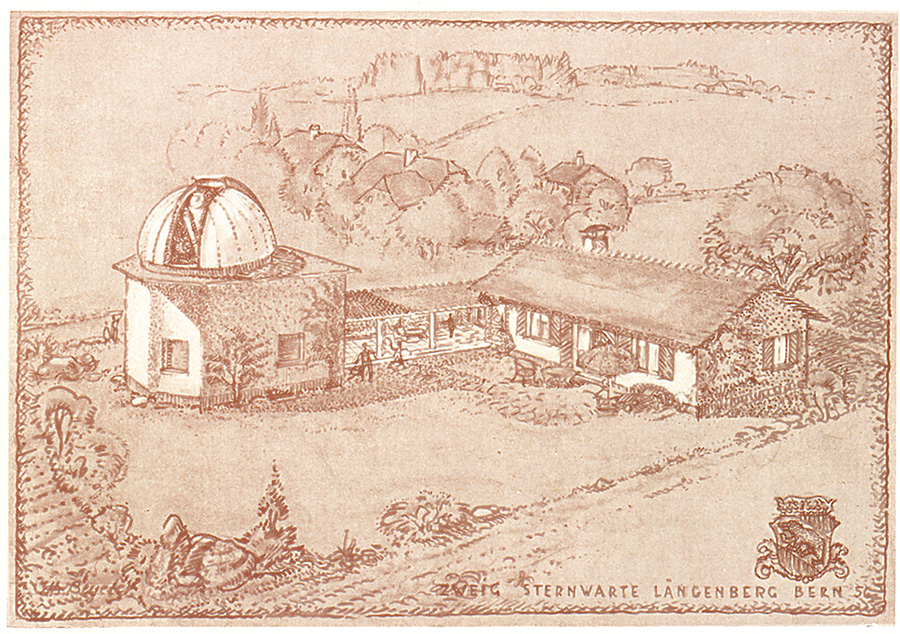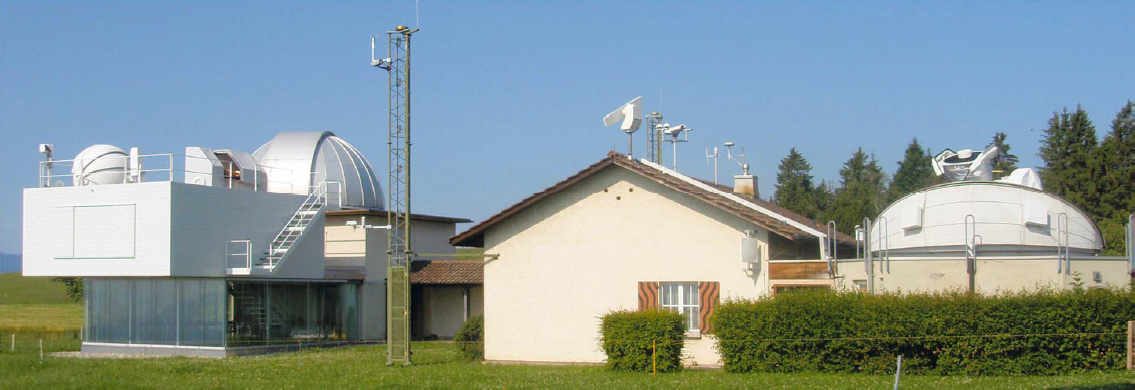The Beginning
The observatory in the village of Zimmerwald (around 10 kilometres south of Bern) was built between 1955 and 1956. In the years 1956 to 1958, it was possible to make observations for the first time with a small Schmidt camera (25 cm aperture, 104 cm focal length).

In 1959 the large Schmidt camera (40 cm aperture, 104 cm focal length) and Cassegrain instrument (60 cm aperture, 13 m focal length) were installed in Zimmerwald.
Most of the scientific observation work was carried out with the Schmidt camera, which was particularly suitable for sky observations thanks to its 6-degree field of view.
Photographc Observations
On March 2, 1957, Prof. Max Schürer discovered a supernova (magnitude 14) in the galaxy NGC2841.
On the 2. Oktober 1957 Prof. Paul Wild discovered Comet 1957f.
Comet Wild-2 was discovered in 1978 and on January 2, 2004, the NASA space probe "Stardust" flew through the tail of Wild-2 and successfully brought comet dust back to Earth.
From around 1965, on the initiative of Prof. Max Schürer, the AIUB took part in the globally coordinated optical observation campaigns of active and passive geodetic satellites. In particular, the GEOS, Explorer, Pageos and Echo satellites were observed with the Zimmerwald Schmidt camera.
As a result, Zimmerwald appeared for the first time as a station in the global network of satellite observation stations. The accuracy of the station coordinates at that time was around 5 metres.
By the mid-1970s, directional observations were increasingly neglected due to the labor-intensive evaluation of photographic observations.
Laser Observations
From 1971 to 1972, the first experiments were carried out with a laser built by the Institute of Applied Physics at the University of Bern (IAP), this was mounted on the astronomical telescope. Valuable experience was gained, but tangible successes were minimal.
From 1974 to 1976, the Zimmerwald satellite observation station (new dome) was built in cooperation with the IAP.
The Bernese ruby laser (1976-1979) was used to carry out test measurements on satellites with an accuracy of around 80 cm.
A new laser was built in 1981-1984, in which the optics, electronics and software were significantly improved. Distances to geodetic satellites could now be measured with an accuracy of around 8 cm.
In 1987 Prof. Werner Gurtner was named as the new director of the Zimmerwald Observatory.
The Fundamental Station
The satellite observation station has been operational since 1984, participating in many international campaigns, in particular:
- MERIT, a 14-month project carried out in 1983/1984 to determine the Earth's rotation using all geodetic spatial methods available at the time
- Wegener Medlas for the study of Mediterranean geotectonics
- NASA's Crustal Dynamics Project (CDP) which posed questions on global and regional geodynamics
- IERS (International Earth Rotation and Reference Systems Service) which emerged from the MERIT project
Since the purchase of the first CCD camera (Charge Coupled Device) in 1989, astrometric observations have once again been carried out in Zimmerwald.
In 1990 the observatory was connected to the internet.
In 1992 cooperation with the Bundesamt Landestopographie (swisstopo) was intensified, swisstopo also contribute to the
laser observations at Zimmerwald.
Since 1995 the Geodesy and Geodynamics Laboratory (GGL) of ETH Zurich has been involved in the
construction and operation of a gravimeter station at the Zimmerwald Observatory.
In 1997, ZIMLAT, a new 1 m telescope for astrometric and laser observations, was installed.
With the establishment of the International Laser Ranging Service (ILRS) in 1998 Zimmerwald became one of the
observation stations of the service.
The Zimmerwald Observatory celebrated its 50 year anniversary in 2006. And in the same year a new building was erected for the Institute of Applied Physics (IAP),
which primarily houses experiments for atmospheric research. The AIUB installed a robotic telescope for optical satellite observations on the roof of this new building.
In 2009 Prof. Dr. Thomas Schildknecht was made director of the observatory.
Laser signals were successfully sent to the Lunar Reconnaissance Orbiter (LRO) in 2010.
In 2018, the observatory was expanded with two new domes. In the southernmost external tower (ZimTWIN), two 40 cm telescopes are in use. The northern tower is used for
testing telescopes. For example, as part of the SMARTnet cooperation with the DLR, telescopes were
tested and commissioned there, which were then shipped to Australia, South Africa, and Chile to build a global network of telescopes.
During the renovation, the older 60 cm Cassegrain telescope was also replaced with a new 80 cm Ritchey-Chrétien telescope from ASA, along with a new dome (ZimMAIN).
In 2022, the ZIMLAT dome was replaced with a high-speed slit dome. As part of the major renovation, the cooling system was also redesigned.
In 2024, the University of Bern established, for the first time, a
structural professorship for the leadership of Zimmerwald, and appointed Prof. Dr. L. Kleint to the position.
As a result, the observatory is now also officially represented within the faculty (in contrast to the previous affiliated and titular professorships without independent funding).
In 2025 Prof. Dr. Lucia Kleint was installed as the director of the Zimmerwald Observatory. She is the first female director in Zimmerwald (and the first female faculty-member
professor in Astronomy in Bern).
